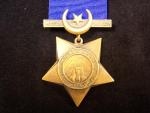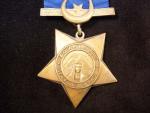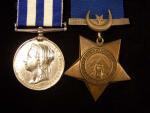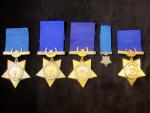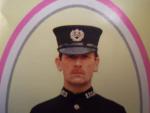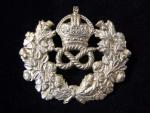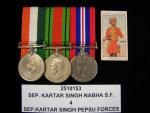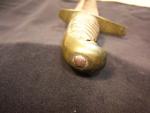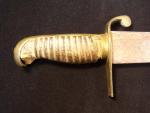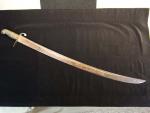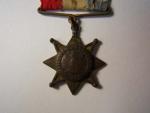-
Posts
6,486 -
Joined
-
Last visited
-
Days Won
10
Content Type
Profiles
Forums
Blogs
Gallery
Events
Store
Everything posted by Brian Wolfe
-

My Khedive's Star Collection
Brian Wolfe replied to Brian Wolfe's topic in Great Britain: Orders, Gallantry, Campaign Medals
-

My Khedive's Star Collection
Brian Wolfe replied to Brian Wolfe's topic in Great Britain: Orders, Gallantry, Campaign Medals
-

My Khedive's Star Collection
Brian Wolfe replied to Brian Wolfe's topic in Great Britain: Orders, Gallantry, Campaign Medals
As I stated earlier, the Khedive's Star was awarded to those who qualified for the Egypt Medal. Due to the points on the Star there is often contact damage to the Egypt Medal. The pair shown here has such damage though it is hard to see from the photo. The point bottom left has left a dent in the medal. The medal is the 1882 - 1889 issue with the date 1882 on the reverse. It was awarded to: 127 Pte. T. Coupe 1/Shropshire: LI. -

My Khedive's Star Collection
Brian Wolfe replied to Brian Wolfe's topic in Great Britain: Orders, Gallantry, Campaign Medals
Here is a view of a typical Khedive's Star. These were awarded in bronze to British troups by the Ruler of Egypt. The obverse show the Sphinx and the Pyramids. Around the top is inscribed EGYPT and the date. Around the bottom in Arabic is the year from the Moslem calandar. The reverse shows the Khedive's momogram. These stars were issued unnamed however specimens are found named. The medal was struck by Jenkins of Birmingham and was awarded to those who qualified for the Egyptian Medal. The title of Kedive means "lord" or "ruler" in Persian and was conferred by the Ottoman Sultan Abd-ul-Aziz in 1867. Tewfik Pasha was Khedive of Egypt from 1979 to 1892. The title of Khedive was used from 1867 to 1914 when it was replaced by the title of Sultan. -
For a number of years I have wanted to complete several type sets. Due to the number of these sets and the cost of adding the most expensive specimens, as is the usual case, it has been a lengthy proposition. This is my Khedive's Star collection of which the undated specimen was just added. I may now add the miniatures (contemporary mints not reproductions) and the proper Egypt Medal for each star. Typical collector, even when the set is finally completed there is still more to add. I will start off with a short history for those not familiar with the Egyptian War of 1882. This is from the National Archives site, http://yourarchives.nationalarchives.gov.u...yptian_War_1882 , and I hope I have not broken any copyright laws as there were no such warnings posted. THE EGYPTIAN WAR 1882 From Your Archives The Suez Canel opened on 16 November 1869, thus giving ships the opportunity to sail to the Far East without having to use the longer and more expensive route via the Cape of Good Hope. It was obvious that whoever controlled Egypt controlled the canal. Egypt was not a rich country and such were its finances that in 1875 Britian bought shares in the Suez Canal. Britian, by having financial control of the canal, had financial control of Egypt. This, in turn, gave rise to unrest between the Egyptians and Europeans, and nationalist feelings started to grow. In February 1881, the Egyptian Army mutinied in favour of one of its colonels, Arabi Pasha and other military leaders. The Khedive, the traditional ruler of Egypt, was unable to stop Arabi's rise to power. A government was formed in 1882 with Arabi as Minister for War. On 6 June 1882, a riot broke out in Alexandria, nationalist feelings were running high. Property was destroyed and a few Europeans, including three sailors of the Royal Navy, were killed. The British became concerned about their interests and feared that the Suez Canal was at risk. Throughout this period of unrest the Egyptian Army had been building forts to protect the port of Alexandria. Admiral Seymour, Commander-in-Chief of the Mediterranean Fleet, was ordered to stop the construction of these forts. After several threats of action, the forts were finally bombarded on 11 July. Army reinforcements were sent in from all around the Mediterranean, the British Isles and even India. After a minor action at Kassassin, the Egyptian army was finally defeated at Tel-el-Kebir on 13 September. Plese be patient as this will take a whilr to post. Not a large collect, just a slow "poster". Regards Brian
-

Canadian Forces Decoration
Brian Wolfe replied to Hauptmann's topic in Great Britain: Orders, Gallantry, Campaign Medals
William Scully also produces insignis for police, fire and security services. This is probably the reason they have managed to stay in business for so long. Regards Brian -
Hello Everyone. When I started posting my Staffordshire collection I thought I would only have a few items to post so they were all entered on their own. Now I wish I had made only one thread and just kept adding as I went along. If you want to see my collection all in one place please go to the New Member's Showcase, the new one that can be accessed through Nick's post that the top of that section. Today I am posting a hat badge to the Staffordshire Police Service that was issued in the reign of Edward VII. It measures 64 mm in width and 55 mm in height. The badge was held on by a pin that went through two metal loops on the rear of the badge, much like military hat badges. There is no maker's mark and there is a small bit of vertigris (that green oxidization) on the back, otherwise this is in mint condition. A photo of a contemporary officer wearing a period uniform with this badge on the correct head gear will follow this entry. Regards Brian
-
Hi Hugh, I hope Doc can help as I am still in the stone age when it comes to scanning. Regards Brian
-
Hello Hugh, That would be invaluable to fellow Pakistan collectors present and future. I look forward to that post. Regards Brian
-
Helen, you are a treasure. I started to look through some old catalogs from The Museum of Historical Arms which was located in Miami Beach Florida. Finally in the last catalog there was an entry that looked correct. This particular catalog was from the mid 1960s. It shows this as the spatula-like butt you have mentioned except they were selling this as from the Malay States. I have found several identification errors in these old catalogs so Nigeria is probably correct. I would think this would help stabilize the spear if it were thrown much as feathers do for an arrow. Thanks to all for your help. Regards Brian
-
Thanks Mervyn. I have not tried the Royal Ontario Museum in Toronto yet either but I do intend to do so if nothing comes up in the near future through my research attempts. The ROM has an area in their collection dedicated to Africa, though I am not sure what areas of Africa are represented. Regards Brian
-
Thanks Peter, It has been driving me crazy trying to remember where I saw one before. The "missus thing" isn't working for me but my wife seems determined to continue to "jar" my memory. Regards Brian
-
I don't think it is Innuit, and thanks for using the correct term, but perhaps the Congo would be a good place to start. I know I've seen these in photos a long time ago. The search continues. Regards Brian
-
Hello Gentlemen, Over ths last few years I have been purchasing photo postcards and actual photos and storing them in mylar (spelling?) top-loader protectors I purchase these from the local sports card shop. The mylar protectors come in many sizes so they fit a range of photos and post card sizes. This was all well and good until I reached a point where I have quite a few photos and the drawer I keep them in is completely full. Do the members use albums with plastic pages? Or are some of these plastic pages bad for these old photos? I really need to do something before they start to flow out of the drawer and onto the floor. Any suggestions are more than welcomed. Regards Brian
-
Hello pikemedals, After reading your post I decided to renew my quest for information regarding the PEPSU forces, earlier research turning up next to nothing. My newest efforts have left me with no more knowledge than when I started. While I can be of no help at the moment I thought I would take this opportunity to post a nice little group with the Independence Medal being to the PEPSU Forces. The small card I display with this group is of a Nabha Lancer. I hope my post will keep this thread "alive" a little longer with the hope other members will see it and enlighten both of us. Regards Brian
-
Hi Mervyn, Here is a close up of the hilt. The grip was leather and covered the standard wooden handle. The knuckle bow has been broken off and the quillion has been bent toward the blade, probably when the knuckle bow was broken. The blade has a fuller on bothsides of the balde. These are at times called "blood grooves" by the uninitiated. These have noting to do with blood or the ease at which the sword may be drawn from the body of an opponet. They are to strengthen the blade much as an "I" beam draws its strenght from its shape. It also lightens the blade somewhat due to the lessening of the metal used in manufacturing the blade. End of sermon. The end of the tang, which runs through the grip is simply penned over rather than having a removable button at the end for the pommel. The sword was not meant to be dissasembled and was a massed produced item and probably supplied in great qualtity. The specimen is a lot darker than the photos show. Regards Brian
-
This is a battlefield find that I purchased over 40 years ago, (I hate to think that it was that long ago), and at the time I paid about $5.00. The shop owner actually didn't even want it in the shop so she let me have it for what she had paid for it. It was found on the site of the Battle of Pigeon Hill, Quebec which took place on Friday, 8 June, 1866. The Fenians were lead by Col. Michael Scanlan, this was a victory for the Fenians. The grip is leather covering wood but very brittle and the hand guard has been broken off, probably by the farmer's plough as it was found in a field. The blade length is 28 inches. I don't know if this is British or American and due to the fact that the Fenians equipped themselves it could be British in manufacture yet used by the Fenians. Still it is an interesting battlefield artifact of an event that helped solidify the Canadian Nation and, I hope, in some small way, the cause for a free Ireland. Regards Brian



